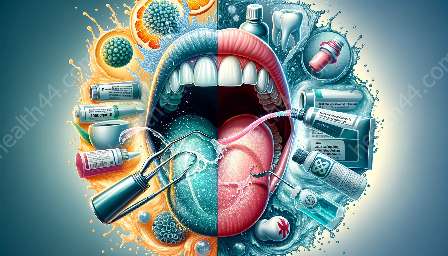Chlorhexidine mouthwash has been widely studied for its efficacy in maintaining oral health. In this comprehensive topic cluster, we will delve into the research findings regarding the effectiveness of chlorhexidine mouthwash, its impact on plaque, gingivitis, and dental caries, as well as its potential side effects.
Efficacy of Chlorhexidine Mouthwash
Research studies have demonstrated that chlorhexidine mouthwash is effective in reducing plaque accumulation and controlling gingivitis. It has been shown to have a significant impact on the overall oral hygiene of individuals.
Plaque Prevention
Chlorhexidine mouthwash has been found to be highly effective in preventing the accumulation of plaque on the teeth. Plaque is a sticky, colorless film of bacteria that forms on the teeth, and if not removed, it can lead to dental issues such as cavities and gum disease. The antimicrobial properties of chlorhexidine help in reducing the formation of plaque, thereby promoting better oral health.
Gingivitis Control
Gingivitis is a common and mild form of gum disease that causes irritation, redness, and swelling of the gingiva, or the part of the gum around the base of the teeth. Research has indicated that chlorhexidine mouthwash is effective in controlling gingivitis by reducing the inflammation and preventing the progression of the condition.
Prevention of Dental Caries
Dental caries, commonly known as cavities, are caused by the demineralization of the tooth enamel by acids produced by bacteria. Studies have suggested that chlorhexidine mouthwash, with its ability to reduce the bacterial load in the oral cavity, can contribute to the prevention of dental caries.
Side Effects of Chlorhexidine Mouthwash
While chlorhexidine mouthwash is known for its efficacy in promoting oral health, it is important to be aware of its potential side effects. Some individuals may experience temporary discoloration of the teeth and tongue when using chlorhexidine mouthwash. This discoloration is usually reversible and can be minimized by proper oral hygiene practices.
In rare cases, some individuals may also develop allergic reactions to chlorhexidine, leading to symptoms such as rash, itching, and swelling. It is advisable to discontinue the use of chlorhexidine mouthwash and seek medical attention if any severe allergic reactions occur.
Conclusion
The research findings on the efficacy of chlorhexidine mouthwash highlight its positive impact on oral health, particularly in preventing plaque, controlling gingivitis, and potentially reducing the risk of dental caries. However, it is essential to use chlorhexidine mouthwash as directed and be mindful of its potential side effects to maintain optimal oral hygiene.









